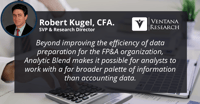A great deal has changed in how finance and accounting departments operate since the start of 2020. To cope with unprecedented conditions, many departments have found that significant changes to their processes and operating methods are not only possible, they’re necessary. With workers unable to be in office, organizations have learned how to work virtually using videoconferencing, and adopted a variety of new software that make it possible to work under any conditions. Software that automates...
Read More
Topics:
Office of Finance,
Financial Performance Management,
robotic finance,
Predictive Planning
One of the challenges of being a practically minded technology analyst is squaring the importance of “the next big thing” with the reality of what most organizations are doing. For decades it’s been the case that “the next big thing” in the world of information technology is easily several years ahead of where most organizations are in their use of technology. And before most organizations can realize the benefit of some whiz-bang technology, they frequently need to address a range of more...
Read More
Topics:
Human Capital Management,
Marketing,
Office of Finance,
Analytics,
Business Intelligence,
Sales Performance Management,
Financial Performance Management,
Price and Revenue Management,
Digital Marketing,
Work and Resource Management,
Digital Commerce,
Operations & Supply Chain,
Enterprise Resource Planning,
ERP and Continuous Accounting,
robotic finance,
Predictive Planning,
revenue and lease accounting,
Subscription Management,
intelligent sales,
AI and Machine Learning
Workiva recently introduced Chains, a visual workflow tool for the Workiva platform. Individuals use Chains to create and manage linear sequences of tasks that they otherwise would have to execute manually, for example, automatically updating a report with the most current dataset. Chains is like old-style Excel macros in its simplicity; users configure sequences with a drag-and-drop visual interface. There’s nothing to code and it’s easy to follow the sequence and the logic that drives the...
Read More
Topics:
Office of Finance,
Financial Performance Management,
ERP and Continuous Accounting,
Reporting, XBRL, iXBRL, document management
FP&A and business analysts can make reporting more effective by reimagining how, what and when their company does its reporting. They should provide the users of their reports the information they want in a form they want it. They should be thinking about how they can make reporting more effective by rethinking how data is presented, how interactive it is, and what visualizations are used. Rethinking how to combine narratives, data, charts and graphics to everyday communications. How to add...
Read More
Topics:
FP&A,
Office of Finance,
CFO,
financial regulation,
financial reporting,
financial risk management,
financial standards,
tax planning
Recent events are forcing corporations to adopt dedicated software for tax provision, transfer pricing and tax analysis. The fiscal damage that the global pandemic is inflicting on countries is likely to result in a more aggressive tax enforcement environment. This will further pressure organizations to establish centralized control and oversight in managing income taxes in corporations. This will also require visibility into tax processes by senior executives, especially for the CFO. Dedicated...
Read More
Topics:
Office of Finance,
Financial Performance Management,
ERP and Continuous Accounting,
tax; tax provision; transfer pricing
In a recent note on virtualizing the close, I observed that finance and accounting organizations that can operate in a virtual mode are better able to adapt to changing circumstances and overcome obstacles. Having systems that people can readily access remotely to collaborate and execute processes virtually makes it easier for departments to meet their commitments with confidence. The core technology underpinning the ability to work in a virtual mode is the cloud. That’s because the cloud...
Read More
Topics:
Office of Finance,
Financial Performance Management,
ERP and Continuous Accounting,
Predictive Planning
Sometimes it takes a while for technology to fundamentally change how work is done. That’s because several innovations usually have to come together before a transformation can occur. For instance, Karl Benz created the first practical motorcar in 1885, but consumers would have to wait until the 1920s for the modern automobile. Computerized accounting systems originated in the 1950s but it’s only now that technologies have evolved and come together to fundamentally change how work is done.
Read More
Topics:
ERP,
Office of Finance,
close,
closing,
CFO,
controller,
Financial Performance Management,
ERP and Continuous Accounting
The global pandemic crisis was, in effect, an unrehearsed stress test measuring the resiliency of the department. The crisis highlighted the importance of sustaining confidence in the accuracy and control of accounting processes, not just efficiency. Virtualizing the close means using technology to substantially reduce the amount of manual processing and paper involved needed to complete the accounting close. Finance and accounting organizations that can operate in a virtual mode are better...
Read More
Topics:
Office of Finance,
Continuous Accounting,
Fast close,
CFO
The Chief Financial Officer can enable her or his finance department play a more strategic role in company operations by adopting what I call profitability management. In the interest of time I’ve made this a very high-level description that’s intended to be just an introduction to the topic. Profitability management is a cross-functional effort. It integrates finance and sales to achieve an optimal balance of revenue and margin objectives. It’s an analytics-based approach designed achieve...
Read More
Topics:
Office of Finance,
Continuous Planning,
CFO,
Financial Performance Management (FPM),
CEO,
Integrated Business Planning
For decades I’ve heard people talk about cutting audit costs to reduce administrative overhead but based on my observations, I was skeptical — mostly because, until recently, the documented success stories haven’t been about going from good to great so much as going from awful to average. That’s changing. I recently wrote about a company that had set out to cut its external auditor’s fees. The benefits it had accrued are significant, including a reduction in staff time devoted to the audit. I...
Read More
Topics:
Office of Finance,
audit,
Continuous Accounting,
financial performance,
CFO




















